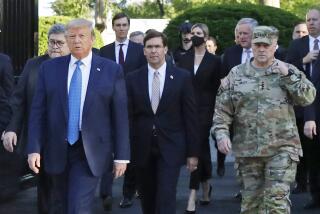With Recruitment Down, Draft Is Gaining Support
- Share via
WASHINGTON — With enlistments slumping and overseas deployments edging upward, key members of Congress’ military committees are thinking the unthinkable: revival of the draft.
While no one expects such a move any time soon, some lawmakers and defense analysts say that the services could be forced to turn to selective conscription if the military cannot fill its ranks by increasing pay and easing the strains of military life.
Because of a torrid economy and the stress of foreign missions, the Pentagon is facing one of its greatest personnel challenges since it turned to the all-volunteer force 26 years ago.
The ultimate answer, said Rep. Herbert H. Bateman (R-Va.), chairman of the House Armed Services subcommittee on readiness, may be “some form of selective conscription.” It is not likely to come “tomorrow, next week or even next year,” Bateman said Tuesday, but it can no longer be ruled out.
Rep. Floyd Spence (R-S.C.), chairman of the House Armed Services Committee, has discussed the same notion, as has committee member Solomon P. Ortiz (D-Texas). Sen. John McCain (R-Ariz.), a member of the Senate Armed Services Committee, also has floated the idea, though aides said that he remained a supporter of the volunteer force.
The draft was abandoned in 1973, near the end of the Vietnam War, after years of protests and complaints about its fairness.
The renewed discussion--the first in a generation--is a sign of policymakers’ frustrations with personnel shortages that appear to be worsening, even though Congress has approved the richest compensation increases for the military since the Persian Gulf War.
The Air Force, for example, this month disclosed that it will fall 2,500 recruits short of its annual goal--for the first time in 20 years--and said that it also expects to be short 1,401 active-duty pilots. It has 12,744. Earlier this year, the Navy said that it would fall 22,000 sailors short of a projected force of 394,000.
To counteract this trend, the Air Force has been reorganizing personnel into 10 “air expeditionary” units in hopes of spreading the burden of overseas duties more evenly throughout the force.
The Navy is adding various new privileges and comforts to show that it views sailors and Marines as “valued professionals,” in the words of Navy Secretary Richard Danzig. It is improving food and adding more shipboard television sets, weight rooms and expanded e-mail privileges. Last winter, the Navy eased rules on physical fitness and excess weight to enable more sailors to avoid dismissal.
Congress has been giving the services added money for pay, education and retirement. The Army, for example, has bumped up its maximum college tuition aid to $50,000 and offers enlistment bonuses that can total $19,000.
The services are easing some requirements and looking for new markets. The Army, for example, is considering accepting more recruits with general equivalency diplomas, instead of high school diplomas, and has been trying to focus on enlistment of more Latinos.
“We’ve got to give all this time to work,” one Senate aide said. “We’re really just starting to try to turn the problem around.”
The all-volunteer army has faced repeated crises in finding and keeping enough young people. Each time, experts said, it has adjusted to shortages by finding new groups of recruits, improving marketing and offering more generous benefits.
Some experts, such as Charles Moskos, a military sociologist at Northwestern University, argue that a draft would strengthen ties between civilians and the military that have frayed as the share of Americans who are veterans has fallen.
A draft, perhaps combined with a mandatory program of national service, could give Americans a better sense of their obligations to their country, some of these experts contend.
Yet most, if not all, military commanders vastly prefer the present system. Remembering the travail of the Vietnam War era, when U.S. forces had drug and disciplinary problems, they say that conscripts can never match volunteers.
“You can’t mandate motivation,” said former Lt. Gen. Theodore G. Stroup, who retired three years ago as the Army’s deputy chief of staff for personnel. “It’s the difference between night and day. Nobody wants to go back to that.”
Another potential obstacle is the question of whether women would have to be included in the draft.
Women now account for 14% of the military, and exempting women would raise questions about fairness. Yet the public would strongly oppose conscription of females, polls have suggested. In 1994, the Clinton administration studied whether it could legally exempt women from a draft but came to no conclusion.
The perceived lack of fairness between economic classes was one reason the draft lost public support during the Vietnam War.
If Congress ever does order the draft reinstated, the government is ready to carry out the instructions in fairly short order. All men 18 to 26 years old are required to register with the Selective Service System, and officials said that they could start providing conscripts within three months at the earliest and six months at the latest.
“We’re here as an insurance policy,” a Selective Service spokesman said. “But if the order came, we’d be ready.”
More to Read
Get the L.A. Times Politics newsletter
Deeply reported insights into legislation, politics and policy from Sacramento, Washington and beyond. In your inbox twice per week.
You may occasionally receive promotional content from the Los Angeles Times.











